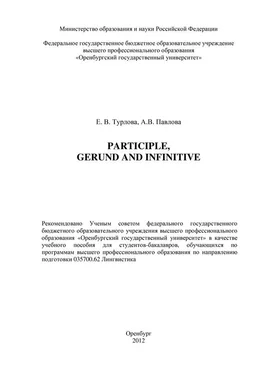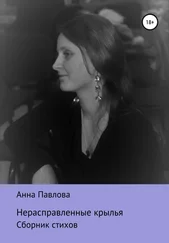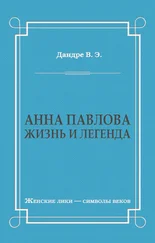Турлова Е.В.
Participle, Gerund and Infinitive = Причастие, герундий и инфинитив. Учебное пособие
Учебное пособие “Participle, Gerund and Infinitive” имеет своей целью систематизацию и обобщение теоретического и практического материала по теме «Неличные формы английского глагола: причастие, герундий и инфинитив» для формирования элементов коммуникативной компетенции, развития речевых грамматических навыков. Данное учебное пособие предназначено для занятий по дисциплине «Практическая грамматика первого языка» для студентов-бакалавров 1 курса очной формы обучения по направлению 035700.62 – Лингвистика, профиль «Теория и методика преподавания иностранных языков и культур» во 2 семестре.
Понимание, усвоение, приобретение навыков владения грамматическими категориями глагола, в особенности неличными формами, представляют наибольшие трудности в овладении и совершенствовании использования английского языка.
Учебное пособие состоит из пяти частей. Каждый раздел включает в себя краткое изложение грамматического материала и упражнения. Материал каждой части структурирован по принципу поэтапной работы над грамматическим феноменом. Последовательность упражнений соответствует последовательности изложения грамматики. Кроме того, каждый раздел содержит речевые упражнения ( Speech Exercises) с последующим анализом грамматический явлений. Каждый раздел рекомендовано начинать с упражнений аналитического характера: Analyze the form of… State the function of… и т.п. с предварительным изучением соответствующего теоретического материала по теме. Упражнения тренировочного характера Choose the proper form… Use the appropriate form… Transform the sentences и т.п. могут быть выполнены на занятиях или даны для самостоятельной работы.
После выполнения упражнений основного раздела (подраздела) рекомендуется перейти к упражнениям Speech Exercises. Часть этих упражнений можно дать учащимся для самостоятельной работы с последующей проверкой. Упражнения творческого характера, направленные на развитие навыков употребления изучаемого материала в речи (Make up sentences… What would you say if you took part in the following short dialogues… и т.п.), необходимо выполнять на занятиях под контролем преподавателя.
1 The non-finite forms of the verb (The verbals)
The verb has finite and non-finite forms , which are also called verbals. The verbals do not express person, number or mood. Therefore they cannot be used as the predicate of a sentence.
e. g. He does his home-work. (does – finite form of the verb, it expresses 3 rdperson, singular, present tense, active voice, indicative mood, non-perfect, non-continuous)
e. g. Watching TV he does his home-work. (watching – non-finite form of the verb, it does not express person, number or mood)
Like the finite forms of the verb the verbals have tense and voice distinctions , but their tense distinctions differ greatly from those of the finite verb.
There are three verbals in English: the participle, the gerund and the infinitive.
In Russian we also have three non-finite forms of the verb – причастие, деепричастие, инфинитив.
1.2 The characteristic traits of the verbals
The verbals have the following characteristic traits:
1) they have a double nature, nominal and verbal – the participle combines the characteristics of a verb with those of an adjective; the gerund and the infinitive combine the characteristics of a verb with those of a noun;
2) the tense distinctions of the verbals are not absolute (like those of the finite verb), but relative; the form of a verbal does not show whether the action it denotes refers to the present past or future; it shows only whether the action expressed by the verbal is simultaneous with the action expressed by the finite verb or prior to it:
e. g. I am glad to see you. (the action expressed by the infinitive is simultaneous with the action expressed by the finite verb; the action of being glad and the action of seeing are simultaneous)
e. g. I am glad to have seen you. (the action expressed by the infinitive is prior to the action expressed by the finite verb; the action of being glad is prior to the action of seeing);
3) all the verbals can form predicative constructions, a predicative construction is a construction consisting of two elements:
– a nominal element (noun or pronoun);
– a verbal element (participle, gerund or infinitive).
The verbal element stands in predicate relation to the nominal element, i.e. in a relation similar to that between the subject and the predicate of the sentence. In most cases predicative constructions form syntactic units, serving as one part of the sentence (complex object, complex subject).
• They sat down to supper, Manston still talking cheerfully .
Они сели ужинать; Мэнстон продолжал весело разговариват ь.
Manston still talking cheerfully is a predicative construction with a participle; the participle talking stands in predicate relation to the noun Mansion, which denotes the doer of the action expressed by the participle.
4) in the sentence a verbal may occur:
a) singly, i. e. without accompanying words:
She… went away smiling .
То decide is to act.
b) in phrases, i. e. with one or several accompanying words (an object or an adverbial modifier to the verbal). The phrases form syntactic units serving as one part of the sentence.
A phrase should not be confused with a predicative construction: between the elements of a phrase there is no predicate relation as it does not include a noun or pronoun denoting the doer of the action expressed by a verbal:
• The windows of the drawing-room opened to a balcony overlooking the garden. Окна гостиной выходили на балкон, с которого был виден сад.
Читать дальше
Конец ознакомительного отрывка
Купить книгу












